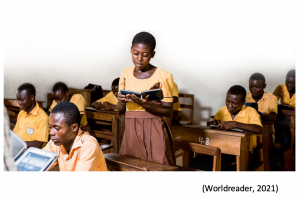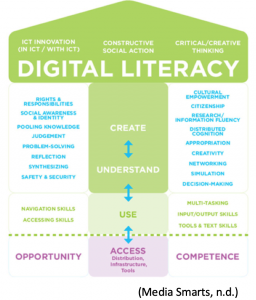
In Phase 2 of LIBE 477 I explored how to use social media to foster reading cultures in schools and to develop personal learning networks. I learned specifically how social media strategies in a professional setting can be a useful communication tool, but it also can be a great mechanism to engage learners. I also explored methods and ways teacher-librarians can support teachers with technology and professional development, focusing on connections, collections, communication and collaboration. My final topic studied, looked at building literacy through developing nations and focused on literacy programs offered by CODE and Worldreader.
What are my key takeaways, learning and direction after all this exploration?
As we explored topics to increase informational literacy, 21st century learning and professional development in Phase 2; the key takeaway for me as a new teacher-librarian is to embrace, submerge, and learn new technology. Integrating technology in a LLC program whether it be through a makerspace, social media or developing a digital literacy program, teacher librarians need to stay ahead of the curve. This will enable them to support the school community – students and teachers. Being knowledgeable in ICT enables TLs to collaborate and assist in professional development with peers. It also helps to ensure use of the acquired technology, whether it is digital tools or equipment. No one wants to see pricey databases sit unused or a makerspace full or technology become a storage closet. Tech savvy TLs enable a LLC program to provide 21st century learning, which promotes new ways of learning that engages students and challenges teachers with new avenues to share curriculum.
When we studied building literacies through developing libraries in developing nations, it struck me that technology was central to the delivery of many of the programs I reviewed. Whether it was through mobile learning lab technology or e-reading technology delivered on 2G or 3G networks, technology was essential to fostering literary initiatives.
What are the new avenues for development in my personal and professional practice?
There are many new avenues for development in my personal and professional practice. I am familiar with our LLC digital tools but really know the ones that are most used. One of the areas I plan to spend more time learning about are the digital tools that I am not using and the tools that I don’t see being used. Could it be because they are not being actively promoted? Is this because I am subconsciously hesitant to recommend them because of my lack of familiarity. Perhaps. I can’t say for sure, but phase 2 made me question:
- Am I tech savvy?
- Am I doing enough to stay ahead of the curve with tech?
Phase 2 has taught me that I need to apply consistent time to this area and I plan to include an element of it yearly in my growth plans going forward. It is not just about learning the databases or Noodle Tools, but how can the technology sitting in the makerspace get used by the wider school community? What can I do to collaborate with staff on curriculum delivery by providing unique technology opportunities?
What am I going to take with me, moving forward from my own explorations and also from the explorations of others in this class?
I learned a lot from exploring the topic on methods and ways teacher-librarians can support teachers with technology and professional development both through my own exploration but also through exploring what others found in this class. Our library has a makerspace and it has a lot of really great new tech items: VR goggles, 3D Printer, green screen, lights, etc. Much of it doesn’t get widespread use and I think this topic has helped me see how my role as a TL can be to help facilitate technology use and support professional development with new tech through building connections, communication and collaboration.
 Some of the peer blogs I read, spoke to ways that could practically engage in teacher collaboration and ICT professional development. Tina Dahlby introduced the idea she found with a Teacher Tech Playground when she shared: “Monique Flickinger had an interesting article that talked about having a Teacher Tech Playground where teachers have the opportunity to play around with various technology. It seems like a low stress, fun and supportive environment in which to learn something new” (Dahlby, 2021). It sounds like a great way to share tech, but also demonstrates a TL’s openness to building professional development opportunities.
Some of the peer blogs I read, spoke to ways that could practically engage in teacher collaboration and ICT professional development. Tina Dahlby introduced the idea she found with a Teacher Tech Playground when she shared: “Monique Flickinger had an interesting article that talked about having a Teacher Tech Playground where teachers have the opportunity to play around with various technology. It seems like a low stress, fun and supportive environment in which to learn something new” (Dahlby, 2021). It sounds like a great way to share tech, but also demonstrates a TL’s openness to building professional development opportunities.
Tiffany Nyquist shared a “bag of tricks” and the “article by “Ivan” on AllDigitalSchool.com. Its title is “15 Resources to Boost Teacher ICT Skills for Better Learning” and it does go through some basic skills but also some very interesting applications that everyone can use to better their skills” (Nyquist, 2021). This resource I bookmarked for future use, as there are a variety of practical tips and resources for developing/improving ICT skills. These resources are helpful for building my knowledge, but also serve as a tool that I can use to help staff that are looking for ICT skill boosters.
If I could pick just one topic from Phase 2 that resonated with me, which is it and why?
Developing my own ICT skills and pedagogy is what resonates the most with me from Phase 2. I have been building our LLC’s social media profile this quarter but extended this to my professional social media platforms. We explored in this course how personal learning networks can connect teachers and enable engagement though social learning settings.
I was new to PLNs before this course and learned to consider utilizing a PLN for both developing my ICT and building on pedagogy. I explored how Twitter could expand my PLN and have since created lists to follow various library professionals and associations. Currently I am building who I follow and haven’t been sharing much beyond our blogs, but this is something that I feel I would like to carry on with after the course. Twitter offers “a way to participate in education-focused conversations and idea sharing with other educators” (Friedman, 2020). I am taking advice from the research I found and I have embraced “follow follow follow!” I will share content soon, but what I learned about building a PLN was contributing to that network is as important as following it. So in order for my PLN to be effective, I will need to commit to contribution and commenting more.
With developing my own ICT, this will help to enable me to share and contribute to others with supporting technology and subsequently build confidence when sharing ideas. The exploration of this topic yielded many useful articles on ways to develop ICT for teachers and teacher librarians. I come back to Doug Johnson’s description of today’s school librarian as being an “ultimate digital resource” (Johnson, 2019). He discusses how “we’ll know students are ‘future ready’ when we see them ‘inquiring, including, collaborating, curating, exploring, and engaging in and outside of the library and across content areas’ and that ‘this will only happen if school librarians collaborate with teachers and share their technical expertise and knowledge of digital resources’” (Johnson, 2019). This means that teacher-librarians must continually evolve and broaden technology expertise to grow within the role.
Works Cited:
Dahlby, Tina. (2021). Supporting Teacher’s ICT Curriculum and Pedagogy. Retrieved 13 March 2021 from: https://tinamarie9.blogspot.com/2021/03/supporting-teachers-ict-curriculum-and.html?showComment=1614992188522#c6671441874585266109
Friedman, Jordan. 2020. “Using Social Media for Teacher Professional Development.” Retrieved 13 March from: https://www.hmhco.com/blog/using-social-media-for-teacher-professional-development
Johnson, Doug. (2019). “The School Librarian: Your Ultimate Digital Resource”. The Tech Savvy School. Educational Leadership. 76(5). Retrieved on 13 March 2021 from: http://www.ascd.org/publications/educational-leadership/feb19/vol76/num05/The-School-Librarian@-Your-Ultimate-Digital-Resource.aspx
Literacy Teaching and Teacher Education. 2014. The Demise of 21st Century Literacy. [image]. Retrieved 13 March from: https://literacyteaching.net/2014/03/31/the-demise-of-21st-century-literacy/
Media Smarts. (n.d). Digital Learning Fundamentals. [image]. Retrieved on 13 March from: https://mediasmarts.ca/digital-media-literacy/general-information/digital-media-literacy-fundamentals/digital-literacy-fundamentalshttps://mediasmarts.ca/teacher-resources
Nyquist, Tiffany (2021). Supporting Teachers Learning with ICT: On-going Pro D. Retrieved on 13 March 2021 from: https://nyquistlibe477.blogspot.com/2021/03/supporting-teachers-learning-with-ict.html
Teachthought. (n.d.). What is a Personal Learning Network”. [image]. Retrieved 13 March 2021 from: https://www.teachthought.com/pedagogy/what-is-a-personal-learning-network/
Worldreader. (2021). “Using digital reading data to improve international education”. Retrieved 13 March 2021 from: https://www.worldreader.org/now/using-digital-reading-data-to-improve-international-education/

 Follow
Follow
Well done reflection and tour through all the key learning for you and discussion of topics that resonated, with examples and connections to resources and people that are forming your personal learning network. A good overview of the most important and influential topics for you in this phase of our course, with lots of resources, connections, websites and examples to further explore. I appreciated you sharing your goals going forward, with important reminders for ongoing development and efforts that will build up your confidence and abilities to support your entire school community.
Hi Nicole!
You’ve got a really great reflective post here! I appreciate all of your thoughts, learnings, and plans for moving forward! While I did not mention it in my blog post, pedagogy is also a concept that resonated with me. It is definitely an area that will always need attention and that will be evolving/changing. Our pedagogy cannot change for the better if we are not willing to change.
Thank you for sharing your thoughts. The statement which most stood out to me in your blog was, “the key takeaway for me as a new teacher-librarian is to embrace, submerge, and learn new technology.” I can relate to this too as I’m also very new to this role. Often staff members ask me about where I learnt how to use this program, and I counsel them to “submerge” themselves in it and just play around. Often, as with was the case with Scratch, Sphero, SnapCircuits and so many more technologies, I brought it home and played around with it with my children. I usually figured out the basics, but it was through answering their questions, and observing their explorations that I deepened my understanding – enough so that I appeared to be an expert to my co-workers! So much of learning is the willingness to temporarily “submerge” yourself in a new experience.